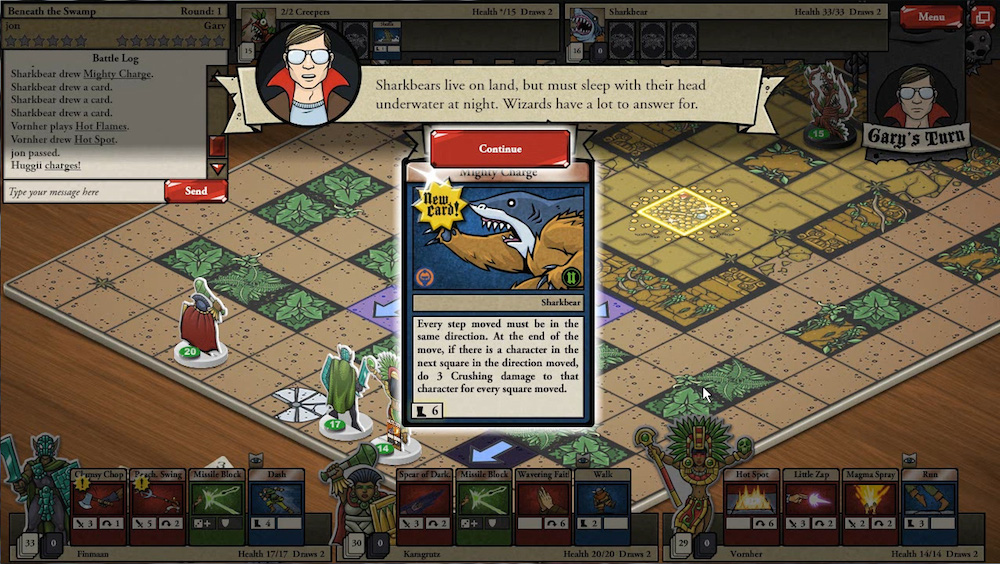Behold the Sharkbear.
It’s a deadly beast, with fierce claws and sharp teeth. But don’t dare call it a Landshark. It’s also another laugh-out-loud monster you’ll find in Card Hunter.
One of the best surprises of 2013 was Card Hunter, the card-based role-playing game that was developer Blue Manchu’s debut. Heaped with humor and love for old-school Dungeons & Dragons, Card Hunter offers fantastic tactical gameplay, an interesting multiplayer mode that pits you against the characters and teams of other players, and a free-to-play model that doesn’t feel like it’s a pay-to-win game. But besides some updates and promotions of player-made adventures (aka modules, as these are known in the pen-and-paper RPG world), content has been light from Blue Manchu since the September release.
Until now.
This week, Blue Manchu launched its first expansion: Attack of the Artifacts. It adds new adventures — including a riff on one of tabletop gaming’s most loved romps — new cards and items, and new monsters. One beast, the Sharkbear, sounds like it jumped right out of the original Advanced Dungeons & Dragons Monster Manual II. We interviewed studio head Jon Chey to find out the origins of the Sharkbear, the expansion’s Aztec influence, and where Blue Manchu may go next.
GamesBeat: How big is Attack of the Artifacts?
Jon Chey: It’s six adventures, three to four battles each, with another 20-something plus battles. It’s a bit of an experiment. We have players who have different approaches — some finish the campaign, and some are still playing campaign. They’re split into two groups.
The expansion has a whole bunch of new cards — 40 new cards — and new items as well. It’s quite a meaty expansion.
GamesBeat: Any new classes?
Chey: No new classes yet. We’re still ruminating on the Rogue class — maybe the next expansion.
GamesBeat: What’s this Sharkbear?
Chey: Well, I would say that as with most of the explanations for early D&D monsters, it seems to be something to do with an insane wizard’s experiments.
We realize that a lot of the inspiration for Card Hunter is early D&D. Looking at our original adventures, thought, lots of monsters are human-like but smaller and different color, like lizardmen and goblins.
But what we love in D&D are all those really weird monsters. Some stayed on and became iconic, and some were too ridiculous and dropped [from D&D]. We want to put in those wacky things like Sharkbear. Remember the [old D&D monster] that sounded like “hypothalamus” — like the hippocampus?
GamesBeat: Does the Sharkbear have anything to do with the iconic Owlbear?
Chey: It has nothing to do with the Owlbear — it draws inspiration from it.
It makes more sense than the Owlbear. The top half is a shark. A monster that could swim and bite you and eats honey wouldn’t make a lot of sense.
Ben [Lee, the art director] says D&D has aquatic monsters — like the Sea Lion — that’s a shark’s tail and lion’s head. But we don’t have aquatic adventures yet. That would be an awesome next expansion — a set of underwater adventures.
GamesBeat: Card Hunter leagues — what are these?
Chey: We’ve been working on that for the last few months. There’s a couple of things really cool about it. It’s really a structured form of multiplayer — short-form tournaments. One of the things that might be popular — really fun, at least for some — will be fixed-deck leagues. Instead of building a constructed deck, when playing in a league, you get assigned a group of characters and decks, like a preconstructed scenario. These have cool things like one-use cards and creatures you never usually use in regular play, like dragons and Sharkbears and other monster cards. And I also like it because we can really broaden the scope of the game.
Ben and I have been testing the Geomancer league, which is all about using cards that create destructive terrain on the board. You don’t have ways of hurting enemies directly with your players — you throw down ridiculous amounts of lava or acid spells at your foes instead. It freshens up the game. It’s obvious that the hardcore multiplayer folk have discovered the best cards and settled into set builds — we’re back to just thinking about how to use cards in the best particular way.
On the other side, we will also run constructed leagues where you can prebuild decks and use new and really different maps where you can fly and pass over water. We really want to freshen up the metagame. Cool to win pizza [an a premium in-game currency] or figures.
GamesBeat: Do you want to make Card Hunter an e-sport?
Chey: An e-sport? That would be nice.
I don’t think we’re looking that far ahead. That’s sorta of something that will happen or not. If we can build up a solid enough community, that sort of thing will take off. We have a good group in multiplayer, but we don’t have the critical mass yet to take off. With the leagues and other initiatives, hopefully, we can build that community.
Multiplayer is such a chicken-and-egg thing. Luckily, enough people are playing it that it’s self-sustaining. But it needs a push to get the community larger.
We’re hoping that one of next things we do to build our player base is getting a downloadable game client out, which I think could give the our browser-based game a new lease on life.



